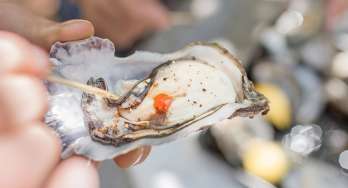Options for Cook Strait ferry travel in New Zealand
New Zealand’s North and South Islands are separated by the Cook Strait – a stretch of water that makes ferry travel an essential part of any road trip between the two. Thankfully, taking a motorhome across couldn’t be easier.
Two ferry operators run daily services across the strait – Bluebridge and Interislander. Both operate a simple drive-on, drive-off system – just park your motorhome in the designated area, grab what you need, and head upstairs to enjoy the ride. There’s plenty to keep you comfortable on board, with lounges, cafés, and viewing decks, plus cinemas on some sailings. Whether you fancy a meal, a movie, or some fresh air as you take in the views of the Marlborough Sounds, the crossing is all part of the experience.
How long does it take to cross the Cook Strait?
The ferry crossing between Wellington and Picton takes around 3.5 hours, giving you plenty of time to relax and enjoy the ride. Along the way, you’ll see the rugged coastline of the North Island, the open waters of the Cook Strait, and the sheltered inlets of the Marlborough Sounds.
The journey time can vary slightly depending on the weather and sea conditions, so it’s always good to allow a little extra time in your schedule.
Wellington – Picton by campervan: Sit back and enjoy the view!
An epic New Zealand road trip covering both islands wouldn’t be complete without the ferry crossing between Wellington and Picton. But this isn’t just a means to an end – it’s a chance to take in some of the most spectacular and iconic coastal scenery in New Zealand.
As you leave Wellington, you’ll cruise past the city skyline before heading into the Cook Strait, where the open sea stretches out ahead. Some days, the water is calm and glassy; other days, the strait reminds you why it has a reputation for being a little unpredictable. Either way, it’s all part of the experience. The final leg of the journey takes you into the Marlborough Sounds, where forested hills rise steeply from the water, and the ferry weaves its way through quiet, sheltered bays.
There’s no need to stay in one spot for the journey – grab a meal from the café, find a sunny spot on the viewing deck, or settle into a lounge with a book. If you’re lucky, you might even spot dolphins or seals along the way. However you choose to spend the crossing, it’s a memorable part of any New Zealand road trip.
How much does it cost to take a motorhome on the ferry?
Motorhome and campervan ferry prices vary depending on your vehicle’s size, the time of year, and which sailing you choose.
The easiest way to get an exact price is to check the Bluebridge and Interislander booking pages. Just pop in your travel date, number of passengers, and vehicle details, and you’ll get an instant quote. You’ll also see options for extras like premium seating or private cabins if you’d like a bit more comfort on the crossing.
Both ferry companies offer similar pricing, and you might find discounts for off-peak travel or return trips. Prices can change depending on demand, so it’s worth booking ahead – especially during busy travel periods. If you’re flexible, checking both ferry websites can help you find the best deal for your trip.

Planning your ferry crossing
If you're planning to take your campervan hire across the Cook Strait, booking your ferry in advance is a smart move. Sailings can fill up quickly, especially during the busy summer months (November to March) and around major events. Locking in your spot early not only secures your place but also gives you more options to choose a departure time that fits your travel plans.
Not sure where to start? The friendly team at maui can take care of your ferry booking once you’ve decided on the day and time that suits you best. Just get in touch, and we’ll sort it for you:
Email: Sales.Direct@THLONLINE.com
NZ phone: 0800 688 558
International phone: +64 255 3910
Please note that the cost of your ferry crossing is not included in your maui motorhome hire.
Boarding your motorhome
Taking your motorhome on the ferry is straightforward but knowing what to expect can make things even smoother. Here’s how the process works, from check-in to disembarking.
Step 1: Prepare your motorhome
Before heading to the terminal, make sure everything inside your motorhome is secure. Lock cupboards, stow any loose items, and turn off your gas supply. You won’t be able to access your vehicle during the crossing, so take anything you’ll need – such as warm clothing, devices, or snacks – with you.
Step 2: Check in at the terminal
Arrive at the terminal at least an hour before departure, as check-in closes 60 minutes before sailing for both Interislander and Bluebridge. Follow the signs for vehicle check-in, where staff will confirm your booking and provide boarding instructions. Passengers not travelling in the motorhome may need to board separately via the passenger terminal.
Step 3: Driving onto the ferry
When boarding begins, ferry staff will direct you onto the vehicle deck. Follow their instructions carefully, as they will guide you into place. Once parked, turn off your engine, apply the handbrake, and lock your motorhome before heading upstairs to the passenger areas.
Step 4: Enjoy the crossing
Both ferry operators offer plenty to do during the journey. You can relax in the lounges, grab a meal from the café, or head to the viewing decks for fresh air and great views. Some sailings also have cinemas, free WiFi, and private lounges if you want a quieter space.
Step 5: Disembarking
As the ferry approaches Wellington or Picton, an announcement will let drivers know when to return to their vehicles. Make your way back to the vehicle deck, where staff will direct you off the ferry. From there, you’re ready to hit the road and continue your trip.
Things to do on the ferry
Once you’ve parked your motorhome and headed upstairs, it’s time to sit back and make the most of the crossing. There’s plenty of time to eat, relax, and take in the views. Whether you want to stretch your legs on the viewing decks, catch a movie, or enjoy a meal, the journey across the Cook Strait offers more than just a break from driving. Here’s how to make the most of your time on board.
Take in the views
One of the best things about the crossing is the scenery. As you leave Wellington, you’ll pass the city skyline before heading into the open waters of the Cook Strait. The final stretch through the Marlborough Sounds is especially impressive, with forested hills, quiet bays, and the occasional pod of dolphins swimming alongside the ferry. If the weather’s good, head out to the viewing decks for fresh air and a front-row seat to the changing landscapes.
Grab a meal or a drink
Both Interislander and Bluebridge ferries have cafés serving hot meals, snacks, and drinks. Whether you want a quick coffee or a full meal, there’s a good selection on board. Some sailings also offer premium lounge access, where you can enjoy complimentary food and drinks in a quieter space.
Watch a movie or go online
If you feel like unwinding indoors, some ferries have cinemas where you can catch a film during the crossing. Free WiFi is also available on most sailings, so you can browse, stream, or catch up on emails while you travel.
Relax in the lounges
Need a quiet spot to sit back and recharge? The standard lounges offer comfortable seating and large windows for watching the views go by. If you’d prefer a bit more space, both ferry operators have premium lounges where you can enjoy a more private and peaceful atmosphere, along with food and drinks.
Keep the kids entertained
Travelling with little ones? Some ferries have dedicated play areas to keep kids busy during the trip. Between that, the onboard movies, and plenty of space to explore, there’s enough to keep them entertained until it’s time to disembark.
Top North-South road trip travel itineraries
Travelling between New Zealand’s North and South Islands by campervan is one of the best ways to experience the country’s diverse landscapes, from rugged coastlines to rolling vineyards and alpine scenery. Whether you're planning for a quick trip packed with highlights or a more leisurely journey through New Zealand’s food and wine regions, these itineraries are a great place to start.
Garden City to City of Sails: Christchurch to Auckland – 6 days
If you’re looking for a New Zealand road trip packed with must-see destinations, this 6-day itinerary is a great choice. Highlights include the bubbling mud pools and geysers of Rotorua, the golden beaches of Cathedral Cove, and the famous Hobbiton Movie Set. Along the way, there’s plenty of time to soak in natural hot pools and take in some of New Zealand’s most iconic sights.
The classic New Zealand wine trail: Auckland to Queenstown – 7 days
Food and wine lovers will love this 7-day road trip through New Zealand’s top wine regions, including Hawke’s Bay, Martinborough, and Marlborough. Stop for tastings at world-class wineries, dine on fresh local produce, and enjoy the stunning vineyard landscapes that make this route a must for wine enthusiasts.
Seafood, scenery, and city highlights: Christchurch to Auckland – 6 days
For a mix of coastal scenery, great food, and vibrant city life, this 6-day travel itinerary is a fantastic option. Enjoy freshly caught seafood in Kaikōura, cruise through the Marlborough Sounds, and experience Wellington’s thriving arts and café scene before continuing north.
The ultimate NZ road trip: Christchurch to Auckland– 11 days
If you have more time, this 11-day travel itinerary takes you from the South Island’s stunning alpine regions to the North Island’s golden beaches. Along the way, you’ll have the chance to go whale watching in Kaikōura, hike in Nelson Lakes National Park, sample wine at Craggy Range, and unwind at Mount Maunganui.
Ready to cross the Cook Strait?
A campervan road trip is one of the best ways to experience New Zealand, giving you the freedom to explore both islands at your own pace. From cruising through the Marlborough Sounds to discovering world-class wineries or relaxing in natural hot pools, there’s so much to see along the way.
Start planning your unforgettable New Zealand campervan adventure and book your maui motorhome today.




